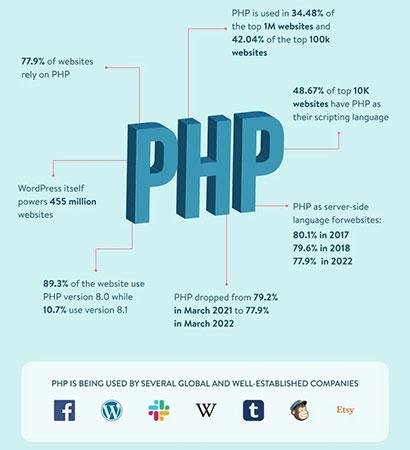
PHP, once the dominant language for building dynamic websites and powering popular platforms like WordPress, Joomla, and Drupal, is facing a steady decline. As the web development ecosystem evolves with modern technologies and frameworks, PHP's relevance is being questioned more than ever. While it’s not entirely obsolete, the "dying days of PHP" is a conversation worth exploring to understand the shifting dynamics in web development.
1. The Rise and Fall of PHP
PHP was created in 1994 by Rasmus Lerdorf as a simple set of tools for creating dynamic websites. Over time, it grew into one of the most widely used server-side scripting languages. Its initial simplicity, open-source nature, and compatibility with early web servers made it a favorite among developers, particularly during the late 1990s and early 2000s.
Factors Contributing to Its Dominance:- Ease of Use: PHP's straightforward syntax allowed developers to quickly learn and implement it.
- Integration with Early CMS Platforms: Platforms like WordPress, Joomla, and Drupal were built on PHP, cementing its place as the backbone of dynamic website creation.
- Massive Community Support: PHP's popularity led to a vast ecosystem of libraries, tutorials, and frameworks, such as Laravel and Symfony.
However, as the web evolved, the simplicity and flexibility that once made PHP appealing began to reveal its weaknesses. Poorly written code, lack of standardization in early versions, and performance bottlenecks led to criticism, especially when compared to emerging technologies.
2. Modern Alternatives Taking Over
The decline of PHP’s popularity is largely due to the emergence of modern programming languages and frameworks that address its limitations. Here are some of the most prominent alternatives:
Node.js
Built on JavaScript, Node.js brought server-side scripting to the front-end developer's toolkit. It excels in creating scalable, high-performance applications due to its event-driven, non-blocking I/O model.
- Strengths: Real-time capabilities, extensive package ecosystem via npm, and cross-platform compatibility.
- Use Cases: Widely used for API development, chat applications, and dynamic web apps.
Python with Django/Flask
Python’s clean and readable syntax, combined with robust frameworks like Django and Flask, has made it a preferred choice for developers. Its versatility extends beyond web development to include AI, machine learning, and data science.
- Strengths: Simplicity, a vast standard library, and strong support for rapid development.
- Use Cases: Web applications, automation, and scientific computing.
Ruby on Rails
Known for its "convention over configuration" philosophy, Ruby on Rails simplifies the development process by reducing boilerplate code and providing powerful tools out of the box.
- Strengths: Fast prototyping, emphasis on developer happiness, and a focus on maintainable code.
- Use Cases: Ideal for startups and MVPs (Minimum Viable Products).
Go (Golang)
Go, developed by Google, is designed for high performance and efficient concurrency handling, making it ideal for modern cloud-native applications and microservices.
- Strengths: High execution speed, simplicity, and built-in tools for testing and deployment.
- Use Cases: Scalable systems, APIs, and microservices.
3. Challenges PHP Faces
Despite significant improvements in recent versions, PHP continues to struggle in key areas that are critical for modern web development:
Performance Bottlenecks
While PHP 7 and 8 have introduced major performance enhancements, they still fall short compared to the speed and scalability offered by Go and Node.js in handling concurrent tasks.
Fragmented Ecosystem
Although frameworks like Laravel and Symfony have modernized PHP to some extent, the language lacks the unified innovation seen in platforms like JavaScript’s React and Angular.
Security Concerns
Early versions of PHP were notorious for security vulnerabilities, and while many of these issues have been addressed, the stigma persists.
Perception Problem
PHP is often associated with "legacy" systems and amateur coding practices. This outdated perception discourages new developers from learning it.
4. The Use Cases Keeping PHP Alive
Despite its decline, PHP remains a critical part of the web development ecosystem. Here are areas where it still holds strong:
- Content Management Systems (CMS): WordPress alone powers over 40% of all websites, making PHP indispensable for its ecosystem.
- Affordable Solutions for Small Businesses: PHP’s low hosting costs and simplicity make it an attractive option for budget-conscious projects.
- Legacy Systems Maintenance: Many existing enterprise applications continue to rely on PHP, ensuring demand for skilled developers.
- Web Hosting Platforms: Shared hosting environments often prioritize PHP support due to its widespread usage.
5. Should You Still Learn PHP?
While PHP’s prominence is fading, it’s not entirely without merit for developers considering whether to invest time in learning it.
Pros:
- Existing Opportunities: A significant portion of the web still relies on PHP-powered solutions, creating a steady demand for maintenance and development work.
- Abundant Resources: PHP has an extensive array of tutorials, documentation, and libraries for developers.
- Strong Community: The community-driven nature of PHP ensures ongoing updates and support..
Cons:
- Limited Career Growth: PHP’s declining popularity may limit opportunities for long-term career advancement.
- Outdated Perception: Employers and startups often prioritize modern technologies over PHP.
- Competitive Alternatives: Mastering languages like Python or JavaScript offers more versatility and relevance in today’s job market.
Conclusion: A Legacy, Not a Future
PHP’s impact on the web development world is undeniable. It democratized dynamic web development and enabled millions of websites, applications, and platforms. However, as the tech landscape continues to evolve, PHP struggles to keep pace with modern standards of performance, scalability, and developer preferences.
While it’s unlikely that PHP will vanish overnight, its role is increasingly shifting from a primary choice to a legacy solution. Developers and businesses need to weigh their options carefully, considering both the benefits of PHP’s extensive ecosystem and the opportunities presented by modern technologies.
For those looking to future-proof their skills or build cutting-edge applications, it may be time to embrace the tools and languages that represent the next era of web development.










